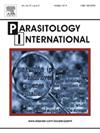A new gallbladder parasite Ceratomyxa costaecola n. sp. (Cnidaria: Myxosporea) infecting the Goldblotch grouper Epinephelus costae (Serranidae) from Tunisian waters
IF 1.5
4区 医学
Q3 PARASITOLOGY
引用次数: 0
Abstract
A new species of Ceratomyxa Thélohan, 1892 named Ceratomyxa costaecola n. sp. was recorded in the gallbladder of the Epinephelus costae (Steindachner) fish found in the Gulf of Tunis, Tunisia. Plasmodia of this species were disporic, ellipsoidal in shape and measured between 13 and 16 μm in length and 20–24 μm in width. The mature myxospores were elongated, crescent-shaped with convex anterior and concave posterior angle, measuring 6.3 ± 0.5 (5.8–7.0) μm in length and 24.7 ± 2.3 (22.0–27.0) μm in thickness. Myxospores with two unequal shell valves, the longer one with a rounded end and the shorter one with a pointed end. Polar capsules were pyriform, equal in size, measuring 2.5 ± 0.1 (2.4–2.8) μm in length and 2.2 ± 0.1 (2.1–2.4) μm in width, with 4–5 coils of polar filament measuring 14.7–26.0 μm long after extrusion. The binucleated sporoplasm filled the entire cavity of the myxospore. The phylogenetic analysis showed that C. costaecola n. sp. was closely related to Ceratomyxa species infecting Epinephelidae fishes and also other fishes families from different localities.
突尼斯水域金斑石斑鱼(Serranidae)胆囊寄生虫costaecola n. sp.(刺胞目:粘孢子目)的新发现
在突尼斯突尼斯湾发现的石斑鱼(Epinephelus costae, Steindachner)的胆囊中发现了一新种Ceratomyxa th lohan, 1892年命名为Ceratomyxa costaecola n. sp.。该物种的疟原虫呈非均匀分布,椭圆形,长13 ~ 16 μm,宽20 ~ 24 μm。成熟黏液孢子呈新月形,前凸后凹,长6.3±0.5 (5.8 ~ 7.0)μm,厚24.7±2.3 (22.0 ~ 27.0)μm。粘孢子有两个不等长的壳瓣,较长的壳瓣末端为圆的,较短的壳瓣末端为尖的。极性胶囊呈梨形,大小相等,长2.5±0.1 (2.4-2.8)μm,宽2.2±0.1 (2.1-2.4)μm,挤出后有4-5圈极性灯丝,长14.7-26.0 μm。双核孢子质充满粘孢子的整个腔。系统发育分析表明,costaecola n. sp.与角鼻虫属(Ceratomyxa)有密切的亲缘关系,感染了不同地区的石斑科鱼类和其他鱼类科。
本文章由计算机程序翻译,如有差异,请以英文原文为准。
求助全文
约1分钟内获得全文
求助全文
来源期刊

Parasitology International
医学-寄生虫学
CiteScore
4.00
自引率
10.50%
发文量
140
审稿时长
61 days
期刊介绍:
Parasitology International provides a medium for rapid, carefully reviewed publications in the field of human and animal parasitology. Original papers, rapid communications, and original case reports from all geographical areas and covering all parasitological disciplines, including structure, immunology, cell biology, biochemistry, molecular biology, and systematics, may be submitted. Reviews on recent developments are invited regularly, but suggestions in this respect are welcome. Letters to the Editor commenting on any aspect of the Journal are also welcome.
 求助内容:
求助内容: 应助结果提醒方式:
应助结果提醒方式:


